5
feeding and digestion
Most insects are herbivores, but a sizable minority are scavengers or hunters. Some are adapted to suck up liquid food, others to bite and chew their way through solids, and their mouthparts and digestive tracts are adapted to handle everything from nectar and blood to flesh and solid wood.
5.5 • Changes during life cycle
5.6 • Drinking and fluid balance
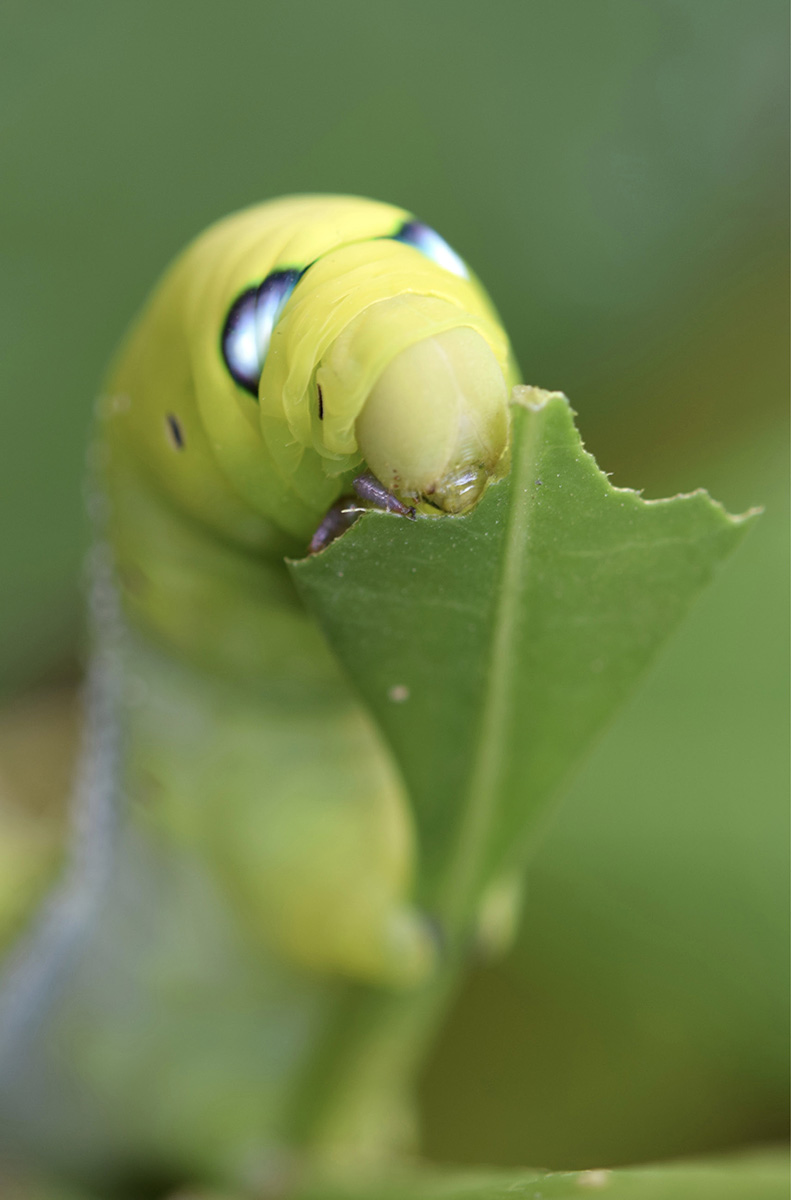
Caterpillars are eating machines, consuming thousands of times their own body-weight during their few weeks of activity between hatching and pupation.
mouthpart anatomy
Many of the major insect groups can be distinguished by (among other things) the structure and function of their external feeding equipment—their mouth appendages or mouthparts.
The human diet is diverse, and in our mouths we have all the tools we need in one place to cut up, grind up, lick up, or suck up whatever we want to consume. Most insects, though, specialize in one style of eating only, and have mouthparts adapted for that purpose.
The mouthparts originate as appendages from the six head segments and sclerotized plates of the cuticle. They include jointed, highly maneuverable parts, more rigid parts, and sensory structures (palps). In general terms, insect mouthparts have up to five principal components:
• Labrum: a sclerotized plate that functions as an upper lip
• Mandibles: paired strong, biting, or crushing appendages that work as jaws
• Maxillae: paired, delicate appendages that manipulate food and are attachment points for sensory palps
• Hypopharynx: usually a small tongue-like structure that adds saliva to food and assists with swallowing
• Labia: paired and fused appendages that function as a lower lip, and also have sensory palps

The head of a typical bee, showing the biting and licking mouthparts: The hypopharynx (not shown in this view) contains glands, which in honeybees secrete royal jelly.
Insects with this basic arrangement include the grasshoppers and crickets, cockroaches, and some beetles. However, in many more recently evolved insects the mouthparts are highly modified and some elements have been discarded. In the true bugs (Hemiptera), the mandibles and maxillae are fused and reshaped to form a firm, sharp-tipped tube with which the insect can pierce plant or animal tissue and suck liquid from it. Adult butterflies and moths lack mandibles, and part of their maxillae are fused and formed into a long, flexible sucking tube (proboscis), which when not in use is coiled up between the enlarged sensory palps of the maxillae.
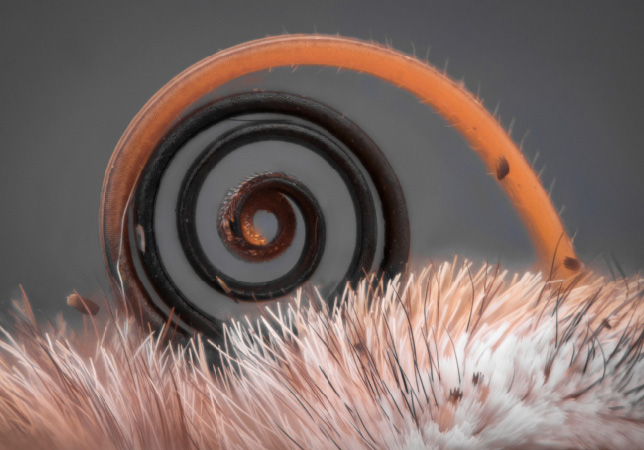
The coiled sucking proboscis of butterflies and moths is a flexible tube, formed by the maxillae.
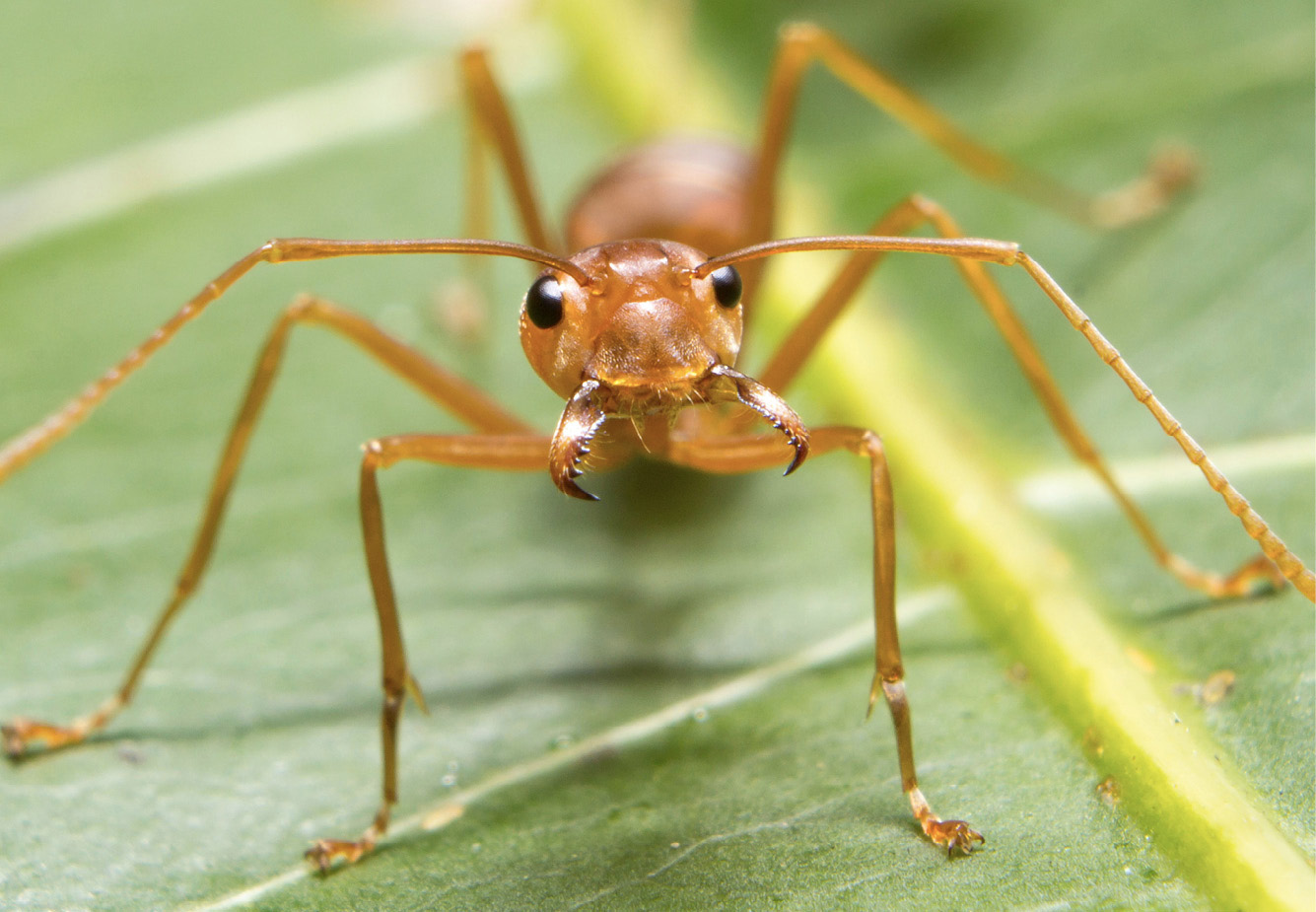
Ants have large, strong mandibles, suitable for biting and grabbing.
larval mouthparts
Because an insect larva does little but feed and grow, its mouthparts are often more obvious and much more heavily used than those of the adult. The majority have fully functional mandibles and eat by biting and grinding their food. The larvae of dragonflies and damselflies are notable in having a spine-tipped labium that can “fire” forward at high speed to pierce prey.
types of diet
Organic matter of all kinds is fair game for at least some kinds of insects. Some are generalists in their diet, with generalized mouthparts to match, while others are extreme specialists.
At least two-thirds of all insect species are plant-eaters (herbivores). Of the rest, most are meat-eaters, feeding on the bodies of other animals that they kill, parasitize, or scavenge (carnivores), and a relatively small proportion (under 10 percent) eat plants and meat, and are classed as omnivores. In some cases, the larval and adult diets are quite different.
Insects that feed on plants may consume the foliage (typically using mandibles to bite pieces out), suck the sap from stems (as many true bugs do, with their sharp, piercing mouthparts), or take nectar from flowers. Nectivorous species obtain nectar in a variety of ways—for example, using an extensible sucking proboscis, as described on the previous page, in the case of butterflies and moths, or a sheathed, licking tongue formed from parts of the maxillae and labium in bees (which also have mandibles to eat pollen). Some foliage-eaters have a highly specialized diet, only feeding on a single plant species and only using those individual plants that are growing in specific conditions.
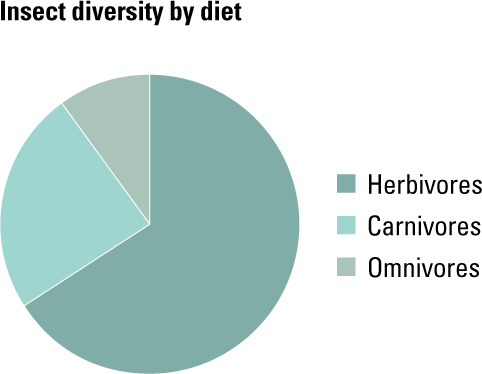

Hoverflies and many other true flies have broad spongelike tips to their labium, which draw in liquids.
Insects that are carnivores may capture live prey, as dragonflies and mantises do, eating prey by taking out bites with their mandibles. Most predatory insects catch other insects, though there are documented cases of large mantises catching tiny vertebrate prey, such as hummingbirds. Omnivorous insects include some members of the order Orthoptera, such as the Great Green Bush Cricket, Tettigonia viridissima, which preys on other insects but also chews up plant foliage. Other omnivores feed on dead or decaying plants, and/or animals.
bloodsuckers
Drinking the blood of vertebrates is a lifestyle followed by a small number of insects. Fleas are flightless parasites that usually have a particular host species (though may at times feed from another, as many cat and dog owners have found out). There are also many blood-drinkers among the true flies, such as mosquitoes and horseflies, the females of which feed on blood from any suitable host they find. They may also eat other foods such as nectar, but they are unable to form their eggs without the protein they obtain by consuming blood. Blood-drinking insects have anticoagulants in their saliva, so the blood from the wound they make does not clot before they have finished feeding.
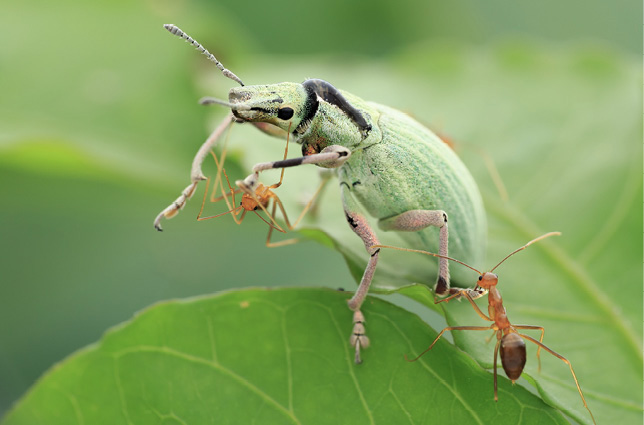
Weevils are herbivores, and may be hunted by predators like ants.

Mosquitoes and some other true flies feed on the blood of vertebrate animals.
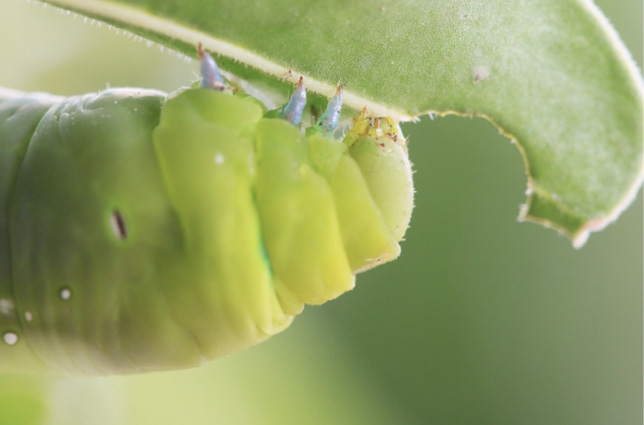
Caterpillars consume large amounts of plant foliage.
the digestive tract
The food that insects and other animals eat needs to be processed to have valuable nutrients extracted, before what is left is excreted. This is the job of the digestive tract.

The insect digestive tract has three main regions. Food breakdown occurs mainly in the foregut, food absorption through the mid- and early hindgut, and reabsorption of water in the hindgut.
Some invertebrates, such as flatworms, take in food and excrete waste through the same opening, but the insect digestive tract, or alimentary canal, is a so-called complete digestive system, with food taking a one-way journey from mouth to anus via three main functionally distinct regions: the foregut, midgut, and hindgut.
Food is mixed with saliva in the insect’s mouth, to aid swallowing and begin digestion. Each pair of mouthparts has an associated pair of glands (though not all are present in all insects), some of which produce saliva. This is carried to the mouth via ducts. The food then passes into the first part of the alimentary canal, the foregut, through the action of the cibarial muscles around the base of the mouth, which contract to create suction that pulls the food in.
The foregut contains the crop, an expandable part of the tract where food is stored prior to further processing. This organ allows the insect to consume a meal quickly, and some digestion via the salivary enzymes may occur. Digestion begins in earnest when the food passes into the proventriculus. This is a muscular organ, lined with sharp projections that mechanically break up food.
In the midgut, food reaches the ventriculus, where it is doused in digestive enzymes, and nutrients are absorbed through tiny projections (microvilli) on the cells lining the wall. Waste removal takes place in the hindgut, where numerous very fine tubes (Malpighian tubules) branch off the gut. They remove ammonia from the insect’s hemolymph (its equivalent of blood) and return it in the form of uric acid to the hindgut for excretion. The other main function of the hindgut is to reabsorb water and salts from what remains in the gut, before the waste is excreted via the rectum.
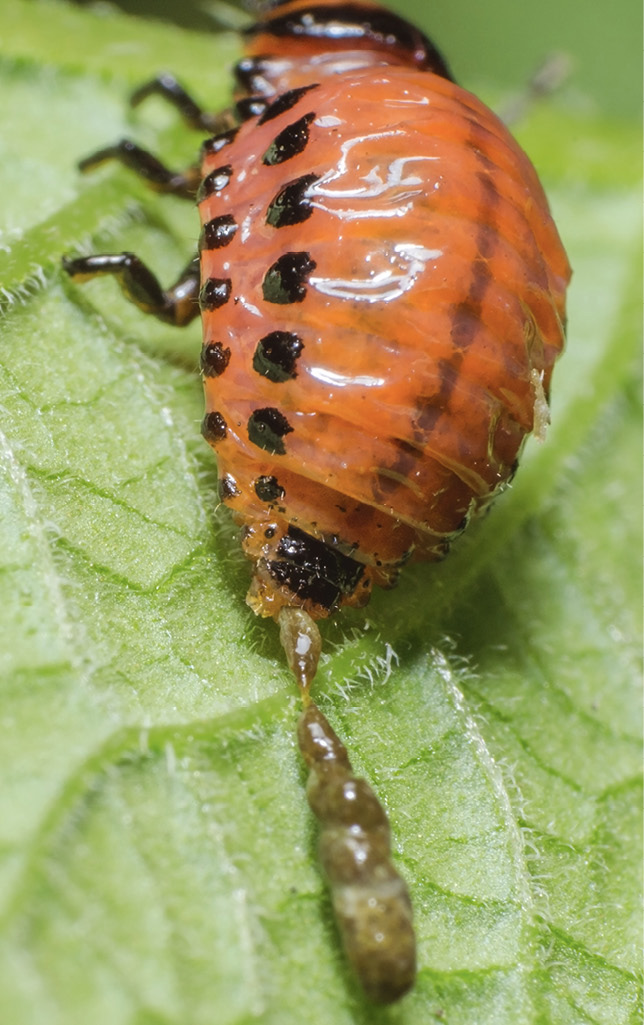
All insects that consume food will excrete some form of waste material.
inner skin
The inside of the crop and some other parts of the gut are lined with a very thin layer of cuticle—the same material that forms an insect’s exoskeleton—known as intima. Just as it works on the outside of the body to protect it from damage, the intima helps protect internal parts from being damaged by hard food particles.

Leaf-mining insects, in this case the larvae of the moth Stigmella aceris, eat their way through the cells within a leaf—the “mine” they create becomes wider as they grow. Their droppings, or “frass,” can be seen within the mine as a dark trail.
processing food
To survive, insects need energy, and to grow and develop, they need building materials. Both are obtained by the breakdown and rebuilding of the organic material that they eat.
The main constituents of the food we (and other animals) eat are proteins, fats, and carbohydrates. All are needed to build body tissues, and all (but especially carbohydrates) are potential sources of energy, too. However, when initially consumed, they are usually in the form of large, complex molecules. Digestion involves breaking them down into very small, simple molecules, which may then be recombined into different larger molecules as required.
Food processing involves mechanical and chemical breakdown. This begins in the mouth—many insects use their mandibles to bite off small pieces of food, and salivary enzymes secreted by the labial glands and hypopharyngeal glands begin to break the chemical bonds holding large molecules together. The enzymes present in the saliva vary according to species—predators’ saliva will contain proteases, for breaking down proteins. That of herbivores contains amylases, for breaking down cellulose and other carbohydrates, and may also contain enzymes that help deactivate toxins in plant tissues.
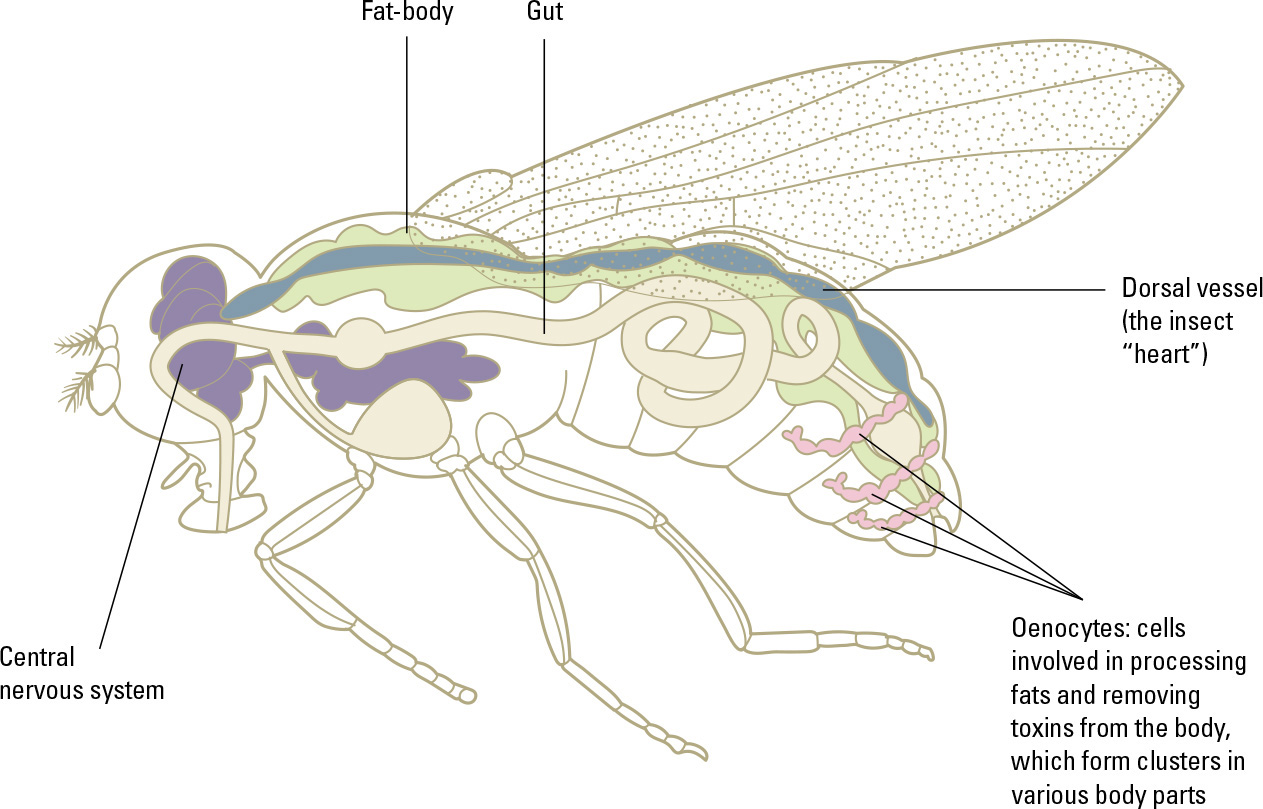
The insect’s fat-body provides storage for lipid, protein, and carbohydrate molecules that are filtered into the hemolymph from the digestive tract.
Further mechanical breakdown occurs in the proventriculus, while the salivary enzymes continue to do their work. In the midgut, more enzymes are secreted to continue chemical breakdown. This section of the gut has no lining of cuticle, just a layer of mucous, so small food molecules can pass through and be absorbed by the microvilli of the cells lining the wall of the gut. Once within the cells, they may be used there and then, or pass via the hemolymph system to other parts of the body. Digestion of nutrients is almost complete after this, but absorption of some salts takes place in the hindgut.

The Goldenrod Gall Fly larva’s secret to its survival through freezing winters may lie in its fat-body.
mini molecules
The long, chain-like molecules of fats, proteins, and carbohydrates can all be broken down to much smaller and simpler molecules, the “links” of the chains. In the case of fats, these are fatty acids. With proteins, the constituent building blocks are amino acids, and with carbohydrates they are simple sugars—especially glucose. From these materials, insects can synthesize new cells for every kind of body tissue, as well as enzymes and hormones. Glucose and fats provide a long-term energy store in the form of larger molecules—glycogen and triglycerides. These are synthesized and stored in adipocyte cells within a specialized tissue called the fat-body. This works in a similar way to the liver in vertebrates, with multiple functions including building and storing energy reserves.
The fat-body may have another special role in certain insects. The Goldenrod Gall Fly, (Eurosta solidaginis), a North American species, spends the winter in its larval form, inside a sheltered crevice. The shelter is not enough to keep it from freezing almost solid, which would usually fatally damage the cells in its fat-body. However, the fat-body of this larva contains an unusual type of fat molecule (acetylated triacylglycerols), which is believed to remain liquid at subzero temperatures, protecting the cells from damage.
changes during life cycle
Once a larva is fully grown, it undergoes metamorphosis—it transforms to its adult form, in some cases via a pupa stage (see chapter 9). This often entails a drastic change of diet, methods, and feeding anatomy.
For many insects that undergo incomplete metamorphosis, the transition from larva to adult involves a less radical bodily transformation and the diet and feeding apparatus changes less drastically than in those insects that pass through a pupal stage. Within the order Orthoptera (grasshoppers, locusts, and crickets), for example, diet and feeding methods usually change very little through development. In the case of Odonata (dragonflies and damselflies), both larvae and adults are predators, but their hunting methods are quite different and their mouthparts are somewhat different, too. The aquatic larvae stalk prey on foot and spear it with their remarkable extensible labium, which fires out at high speed. The winged adults lose this adaptation to the labium. Instead, they capture prey in flight, “netting” it with their bristly legs. If the victim is too large to be eaten on the wing, they keep hold of it with the forelegs and land on a perch with their four free legs.
Among insects that have a complete metamorphosis, the feeding anatomy usually undergoes considerable reshaping during pupation, changing from biting and chewing mouthparts to a more specialized form. Larvae require more food, and food with a higher protein content, than adult insects. Adult insects of some groups feed only on nectar, which provides sugars for energy and almost nothing else. Some do not feed at all but survive on fat stores accumulated in their larval stages. However, adult insects may require certain foods that as larvae they did not need—for example, adult female mosquitoes need to consume some blood to form their eggs, and adult male butterflies of some species need particular salts to produce sperm. Bees of the family Halictidae are known as “sweat bees” as they drink the salty perspiration and tears secreted by mammals such as ourselves.
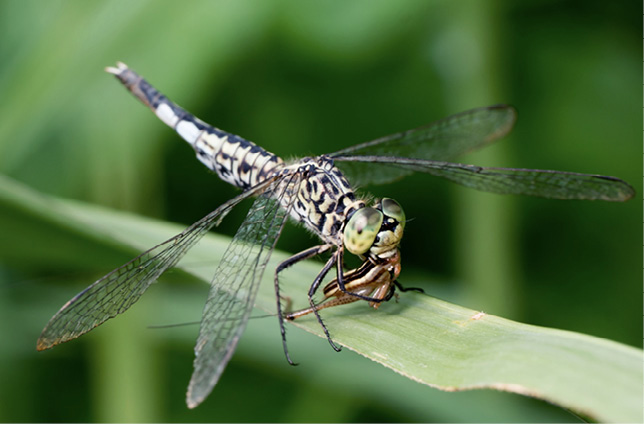
Adult dragonflies are superbly adapted aerial hunting machines—very different in appearance from their aquatic larvae.
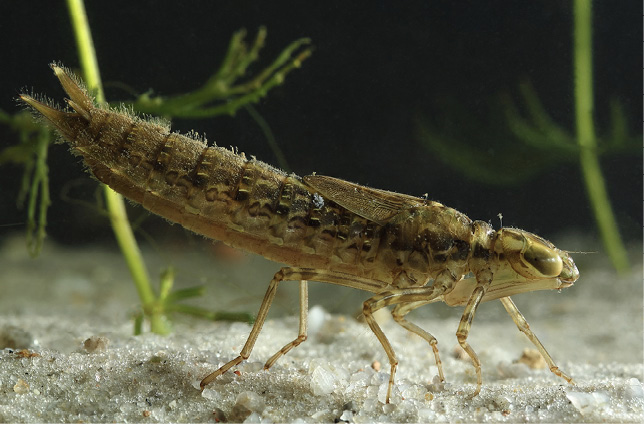
Dragonfly nymphs are slow stalkers rather than high-speed chasers, but are just as predatory as the adults.

Cinnabar Moth caterpillars sequester toxins in their bodies from the plants they eat. These toxins are retained in the adult form.
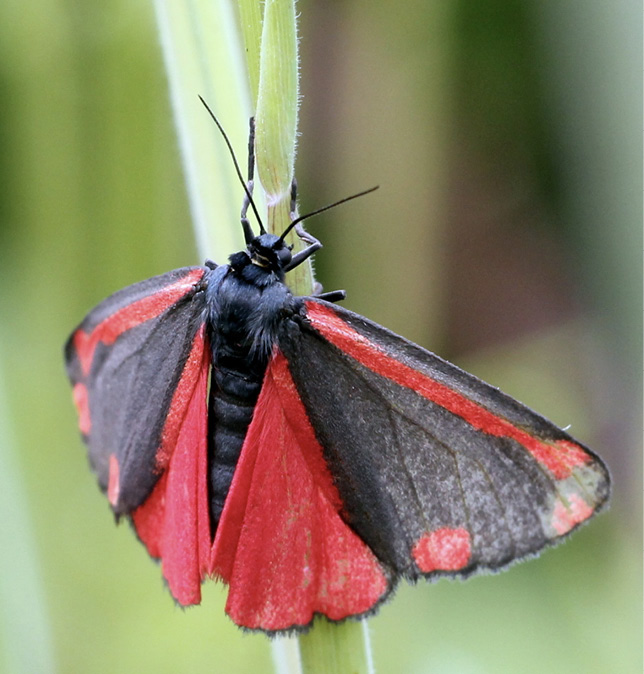
The adult Cinnabar retains these toxins in its body, and, like its younger self, exhibits bright warning coloration.
toxic stockpile
Herbivorous insect larvae have ways of dealing with the toxins that some food plants produce. They might break down the toxins, or alternatively they may sequester or store the toxins intact in their own body tissues. This makes the larva’s own body toxic to any predators that might consume them, and through association predators will learn to avoid similar larvae. For this reason, larvae that sequester toxins usually have a bold and distinctive appearance. The sequestered toxins remain active in the body when the insect transforms into an adult and retain their protective effect, even though the adult insect does not consume anything toxic.
Many moths of the widespread family Erebidae (the tiger moths) sequester toxic alkaloid chemicals in their food, and in some species these same chemicals are then used in adult males to form courtship pheromones.

Adult butterflies consume far less food than caterpillars, but male butterflies need to consume certain minerals in order to form sperm.
drinking and fluid balance
The right fluid balance is essential for survival, and regulating this can be a particularly delicate process for insects with a small body volume, as they are highly vulnerable to dehydration.
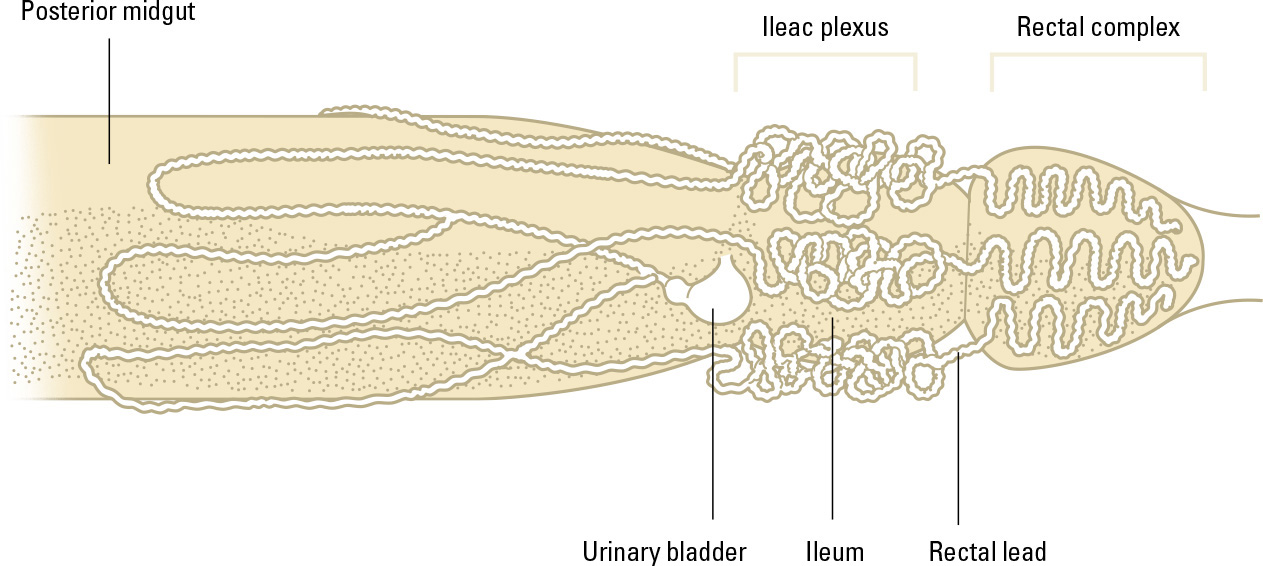
The midgut and hindgut of a caterpillar, showing the Malpighian tubules that extend outward from the gut itself: In the hindgut, the tubules’ coils are gathered into two distinct regions—the ileac plexus, surrounding the ileum, and the rectal complex, surrounding the rectum.
For the earliest insects, transitioning to life on dry land could only take place through evolving an excellent system of fluid regulation. A small body can only hold a small volume of water, which will be lost quickly in conditions that encourage evaporation. On the other hand, too much fluid could damage their bodies, as their cuticles are mostly rigid and, in most cases, cannot expand very far. For larvae, taking on extra fluid before each molt expands the body and helps to break the old cuticle, allowing it to be shed.
Another adaptation is that insects are generally able to cope with much wider variations in their internal fluid level than most other animals. This can be tested by looking at the osmotic pressure (see the chart, opposite), a measure of how dilute or concentrated a fluid is, of their hemolymph. In a housefly, this pressure may vary from 4 to 20 atmospheres, depending on how recently the fly had access to drinking water. By contrast, human blood plasma varies very little (from 7.6 to 7.8 atmospheres).
The tough cuticle with its waxy covering helps prevent water loss through evaporation in insects that live in the open. Water loss occurs primarily through the spiracles (see Chapter 6)—these can be closed to prevent drowning in water, but they can also be closed when the insect is in the air, to prevent water loss during strenuous activity such as flight (at such times, the insect’s oxygen needs can be met by air held in the air sacs within its tracheal system).

This scanning electron microscope image shows the mass of Malpighian tubules extending from a cockroach’s gut.
reabsorption
The Malpighian tubules and other parts of the insect hindgut play a key role in releasing or holding back fluid in the body, with a function analogous to the kidneys in vertebrates. A water-like fluid flows through the tubules. Its low concentration encourages waste products (especially uric acid) to diffuse through from the hemolymph. The fluid passes back into the hindgut, where it is added to the waste products of digestion. Then excess water is reabsorbed in the last parts of the tubules and in the rectum.
